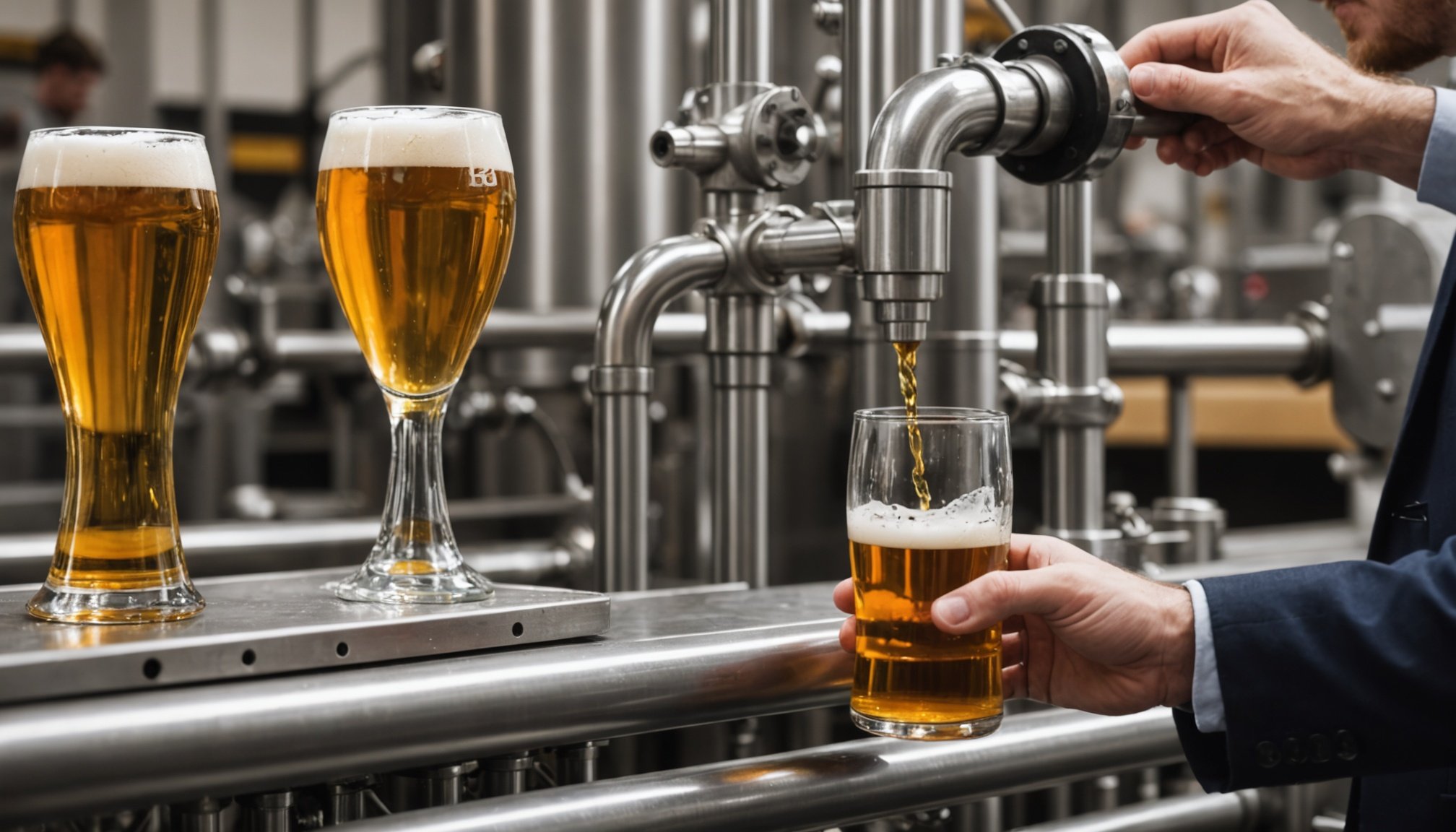Maximizing Productivity: Harnessing Data Analytics to Revolutionize Production in UK Breweries
In the dynamic and competitive world of the UK brewing industry, staying ahead of the curve is crucial for success. One of the most powerful tools in this endeavor is data analytics. By leveraging advanced data analytics, UK breweries can optimize their production processes, enhance efficiency, and meet the ever-evolving demands of the market. Here’s a deep dive into how data analytics is transforming the brewing industry.
The Role of Data Analytics in Brewery Operations
Data analytics has become a cornerstone of modern brewery operations. It involves the collection, analysis, and interpretation of vast amounts of data to gain valuable insights into various aspects of the brewing process. This data can come from multiple sources, including sensors, production logs, and customer feedback.
Also to discover : Discover the Hottest Smart Home Innovations Transforming UK Properties in 2023
Key Metrics for Measuring Production Efficiency
To maximize productivity, breweries focus on several key metrics that can be optimized through data analytics:
- Yield: This measures the amount of beer produced relative to the ingredients used. By analyzing yield data, breweries can identify inefficiencies in the brewing process and make adjustments to improve resource utilization[5].
- Energy Consumption: Tracking energy consumption helps breweries to identify areas where energy is being wasted and implement more sustainable practices. This not only reduces costs but also minimizes the environmental impact of the brewery[5].
- Downtime: Analyzing downtime data helps breweries to identify and minimize periods when production halts. Predictive analytics can foresee potential equipment failures, allowing for timely maintenance and reducing unexpected downtime[5].
Tools and Technologies for Enhanced Production Processes
The integration of advanced analytics tools and brewery software is pivotal for optimizing production processes.
Also to discover : Essential Steps for UK Real Estate Agencies to Effectively Integrate Virtual Tours
Popular Data Analytics Tools
Breweries often utilize a range of data analytics tools to meet their specific needs. Here are some popular options:
- Tableau and Power BI: These platforms offer robust data visualization capabilities, allowing breweries to create intuitive dashboards that provide real-time insights into key metrics such as yield and energy consumption[5].
- RapidMiner: This tool enables predictive analytics, helping breweries to anticipate trends and potential issues, thereby enabling proactive decision-making[5].
- BrewAI™: This platform minimizes the need for manual data entry, allowing breweries to compare their performance against industry benchmarks and make informed decisions based on real-time data[2].
Predictive Analytics and Quality Control
Predictive analytics is revolutionizing quality control in the brewing industry.
Enhancing Accuracy and Consistency
Traditional quality control methods often left room for human error, but AI technologies such as machine learning and computer vision ensure that each batch is scrutinized with precision. Here are some ways predictive analytics enhances quality control:
- Computer Vision Systems: These systems use cameras and sensors to monitor the appearance and color of beer during production, detecting anomalies that might be missed by the human eye[3].
- Predictive Analytics Tools: By analyzing historical data, these tools can forecast trends and deviations, allowing for proactive adjustments to maintain quality throughout the production cycle[3].
Case Studies of AI Implementations
Several UK breweries have successfully implemented AI applications to revolutionize their production processes. Here are a few examples:
- London Brewery: A renowned brewery in London integrated AI technologies to enhance its quality control systems, leading to a significant reduction in production errors and a 20% increase in overall efficiency[3].
- Scottish Brewery: A mid-sized brewery in Scotland utilized AI to optimize its supply chain management, improving inventory accuracy and reducing waste by 15%[3].
Data-Driven Decision Making and Supply Chain Management
Data analytics is not just about optimizing internal processes; it also plays a crucial role in supply chain management and demand forecasting.
Demand Forecasting
Accurate demand forecasting is essential for ensuring that breweries can meet consumer demand without overproducing or underproducing. Here’s how data analytics helps:
- Real-Time Data: By analyzing real-time data on sales, weather patterns, and other external factors, breweries can make accurate forecasts and adjust their production schedules accordingly[5].
- Machine Learning Algorithms: These algorithms can analyze historical sales data and other variables to predict future demand, enabling breweries to make informed decisions about production and inventory management[5].
Inventory Management
Effective inventory management is critical for maintaining efficiency and reducing waste. Here are some ways data analytics improves inventory management:
- Real-Time Monitoring: Real-time monitoring systems can swiftly identify inefficiencies such as overstocking or understocking, allowing breweries to optimize resource use and enhance overall efficiency[5].
- Predictive Analytics: Predictive analytics tools can foresee potential stockouts or overstock situations, enabling proactive adjustments to inventory levels[5].
Environmental Impact and Sustainability
The use of data analytics in breweries also has a significant impact on environmental sustainability.
Reducing Waste and Energy Consumption
By identifying potential issues early in the brewing process, AI systems help prevent costly errors and minimize waste. Here are some ways data analytics supports sustainability:
- Energy Efficiency: Data analytics helps breweries to identify areas where energy is being wasted and implement more sustainable practices, reducing the environmental impact of the brewery[5].
- Resource Allocation: By optimizing resource allocation, breweries can reduce waste and ensure that resources are used efficiently, supporting sustainable practices[5].
Practical Insights and Actionable Advice
For breweries looking to harness the power of data analytics, here are some practical insights and actionable advice:
Start Small
Begin by implementing basic data analytics tools and gradually move to more advanced platforms as you become more comfortable with the technology.
Invest in Training
Ensure that your staff is trained to manage and interpret data analytics. This is crucial for maximizing the benefits of data analytics.
Focus on Key Metrics
Identify the key metrics that are most relevant to your brewery’s operations and focus on optimizing those areas first.
Collaborate with Industry Partners
Collaborate with other breweries and industry partners to share best practices and learn from their experiences.
In conclusion, data analytics is a game-changer for UK breweries, offering a plethora of benefits from enhanced efficiency and quality control to improved supply chain management and sustainability. By leveraging advanced data analytics tools and technologies, breweries can make informed decisions, streamline operations, and ultimately craft better beer.
Quotes from Industry Leaders
- Andy Slee, SIBA CEO: “There is strong demand for beer from independent breweries but this consumer surveying shows there is confusion as to which brewers are genuinely independent and which are owned by globals. This campaign is about ensuring your customers who want to buy beer from local independent breweries are making an informed choice.”[1]
- Jo Farn, Attic Brew Co: “This scheme doesn’t just help to celebrate the many amazing independent brewers crafting excellent beers across the country, it also helps consumers to understand more about the beers on offer, allowing them to make informed decisions that directly support local businesses and economies.”[1]
- David Glenwright, Titanic Brewery: “Most beer drinkers in the UK are unaware that many of the mass-marketed craft beer brands are owned by one of the six global brewers. Yet, the majority of beer consumers also say that they want to buy beer from genuinely independent local breweries.”[1]
Table: Comparison of Data Analytics Tools
| Tool | Key Features | Benefits |
|---|---|---|
| Tableau | Data visualization, real-time insights | Intuitive dashboards, improved decision-making[5] |
| Power BI | Data visualization, real-time insights | Enhanced productivity, better resource allocation[5] |
| RapidMiner | Predictive analytics, trend forecasting | Proactive decision-making, reduced downtime[5] |
| BrewAI™ | Real-time data comparison, minimized manual data entry | Improved performance benchmarking, informed decision-making[2] |
| Computer Vision Systems | Anomaly detection, quality control | Enhanced accuracy, reduced human error[3] |
By embracing data analytics and the latest technologies, UK breweries can not only survive but thrive in a competitive market, ensuring a bright future for this beloved industry.











